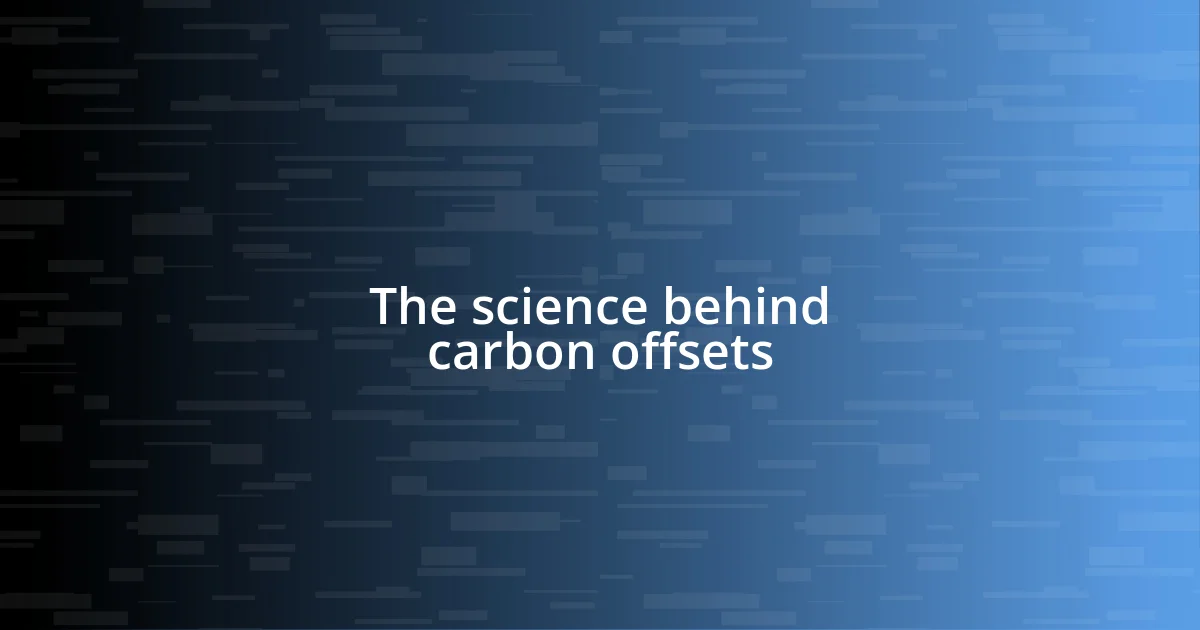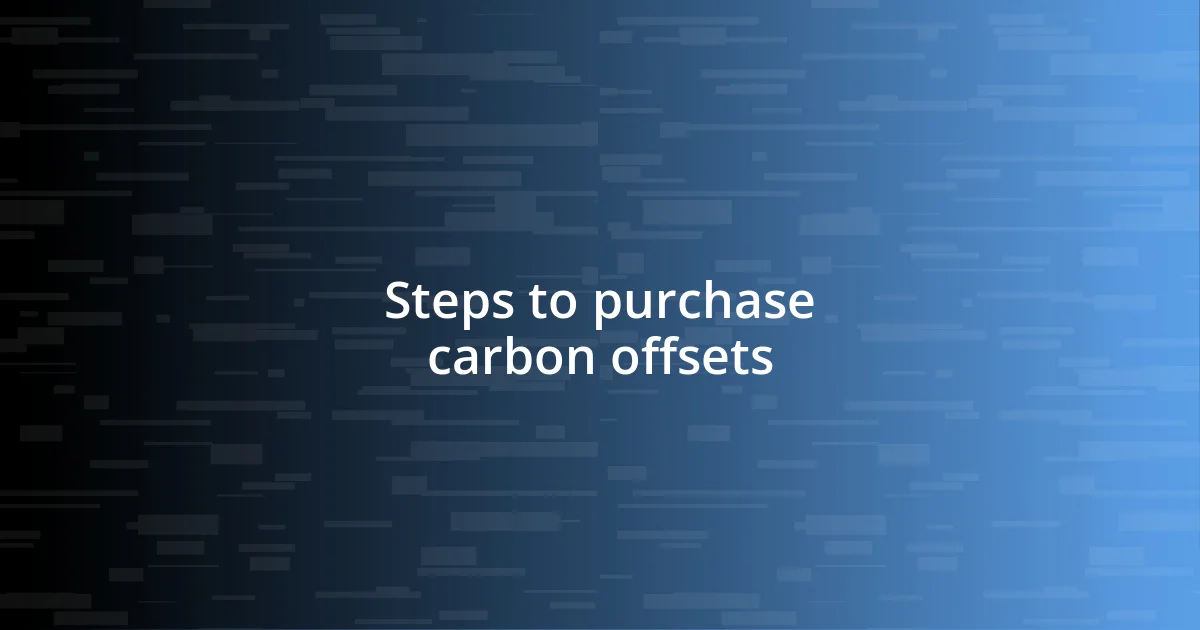Key takeaways:
- Carbon offsets help balance personal emissions by funding projects like reforestation and renewable energy, but should complement, not replace, emission reduction efforts.
- Effectiveness varies among carbon offset projects; verification and community involvement are crucial for ensuring real impact.
- Common misconceptions include the belief that offsets allow for unchecked emissions and that all offsets are equally effective or only environmentally beneficial; many also support social welfare.

Understanding carbon offsets
Carbon offsets are essentially a way to balance out emissions produced by activities like driving or flying by funding projects that reduce greenhouse gases elsewhere. I remember when I first learned about them; it felt like a light bulb went off in my mind. Could this be a practical solution to our climate crisis?
The idea is quite simple: for every ton of carbon dioxide you emit, you purchase an equivalent amount of carbon offsets that fund initiatives such as reforestation or renewable energy projects. It’s a bit like a personal pact with the planet. When I decided to start offsetting my travel, not only did it ease my conscience, but it also connected me to the tangible efforts being made to heal our environment.
However, it’s crucial to understand that offsets are not a free pass to pollute; they should complement efforts to reduce emissions in the first place. Have you ever caught yourself wondering if purchasing offsets truly makes a difference? Personally, seeing the projects I was supporting through detailed reports and updates made me feel empowered and involved in something much bigger than myself.

The science behind carbon offsets
The mechanics of carbon offsets rely on a balance between emissions generated and reductions achieved through various projects. For me, grasping this scientific foundation made my decision to offset emissions more meaningful. I recall one instance where I received a report on a reforestation project. It turned out that the trees planted would absorb a significant amount of CO2 over their lifetime, deepening my understanding of their long-term impact.
Here are a few key elements of the science behind carbon offsets:
- Quantification of Emissions: Carbon offsets quantify how much greenhouse gas each project can eliminate or absorb.
- Global Warming Potential: Different gases have varying impacts on global warming, necessitating the conversion of all offsets into a common metric: CO2 equivalent.
- Verification Processes: Many offsets rigorously undergo third-party verification to ensure projects deliver the expected benefits.
- Types of Projects: These can range from renewable energy initiatives, such as solar or wind farms, to conservation efforts aimed at protecting existing forests.
Just starting this journey made me realize it’s not just about making up for my footprint; it’s about being part of a solution that scientists and environmental advocates design meticulously. The interplay of research and real-world action is what gives carbon offsets their unique power.

Types of carbon offset projects
Carbon offset projects come in various forms, each with its unique approach to combating climate change. From my own exploration, I found that renewable energy projects, like wind and solar farms, not only generate sustainable energy but also provide jobs and local economic growth. I’ve personally witnessed communities thrive around such initiatives, showcasing a win-win for both the environment and the local populace.
On the other hand, reforestation and afforestation projects capture attention as they not only reduce CO2 but also restore ecosystems. I remember visiting a site where volunteers were planting trees. It was profoundly rewarding to see those saplings, knowing they would grow into a forest that would serve as a natural carbon sink, while also supporting biodiversity. The very act of nurturing those young trees deeply connected me to the mission of reversing climate change.
Additionally, I can’t overlook conservation projects aimed at protecting existing ecosystems. These initiatives, whether they focus on wetlands or endangered forests, highlight how preserving what we have is just as vital as creating new green projects. I often think about a documentary I saw that showcased the delicate balance of an endangered habitat. It struck me that our responsibility extends beyond offsets; we must cherish and protect our planet’s treasures if we want to ensure a sustainable future.
| Project Type | Description |
|---|---|
| Renewable Energy | Projects like solar and wind farms that generate clean energy and reduce reliance on fossil fuels. |
| Reforestation | Planting trees to absorb CO2, restore ecosystems, and enhance biodiversity. |
| Conservation | Protecting existing natural areas to preserve their role in carbon sequestration and biodiversity. |

Evaluating carbon offset effectiveness
When evaluating the effectiveness of carbon offsets, I find it crucial to consider the actual impact of each project. During a trip to a wind farm, I saw the turbines in action and learned about the energy produced. It struck me how tangible the benefits were—clean energy powering homes while significantly reducing greenhouse gas emissions. Isn’t that a powerful realization?
However, effectiveness can vary widely among projects. I remember reading about a reforestation initiative where, despite ambitious goals, the survival rate of planted trees was alarmingly low due to poor maintenance and lack of community involvement. This experience made me question: Are all carbon offset projects equally viable? The answer often lies in how well they are managed and whether they engage local communities to ensure sustainability.
Moreover, the verification process plays a pivotal role in establishing trust. While volunteering for a carbon offset organization, I learned about the rigorous protocols for third-party audits. It was fascinating to see firsthand how these measures increase transparency, but it also made me wonder—do we as consumers adequately understand the importance of these checks? Engaging with projects that prioritize comprehensive verification can bring peace of mind to those looking to offset their carbon footprint meaningfully.

Common misconceptions about carbon offsets
Many people believe that purchasing carbon offsets allows them to continue their carbon-emitting habits without any consequences. I used to think that simply buying offsets could erase my environmental footprint. But what I’ve learned is that offsets should be seen as a supplement to reducing emissions, not a substitute for making conscious lifestyle changes. Isn’t it more meaningful to strive for a sustainable way of living while also supporting offset projects?
Another misconception is that all carbon offsets are equally effective. During my research, I came across a project claiming it could sequester miles of CO2, yet when I looked closely, I learned it had weak oversight. It really got me thinking: how can we, as consumers, ensure that our investment goes to projects that truly make a difference? I’ve come to realize that my responsibility extends beyond just purchasing offsets; I must dig deeper to support initiatives that are genuinely impactful.
Lastly, many assume that carbon offset projects only benefit the environment. In my experience, I’ve discovered that numerous initiatives also contribute to social welfare. For example, when I visited a biomass energy project in a remote village, I saw how it not only cut down on emissions but provided sustainable energy and jobs to locals. Witnessing the community benefit firsthand filled me with hope, reminding me that effective carbon offset solutions can foster both ecological and social progress.

Steps to purchase carbon offsets
To begin purchasing carbon offsets, I recommend starting with research. There are numerous platforms out there, but it can be overwhelming to sift through them all. I found that taking the time to read reviews and understanding the specific projects they support really helped clarify my options. What criteria matter to you? I suggest focusing on transparency and impact, as those factors can significantly influence your decision.
Once you’ve narrowed down your choices, the next step is to evaluate the projects. Many sites provide detailed information about their initiatives, which can be both exciting and sometimes disheartening. I once chose a project based solely on its appealing marketing, only to learn later that it lacked community involvement. Reflecting on that experience, I now prioritize projects that not only explain their environmental impact but also highlight how they engage local communities. Isn’t it reassuring to know your contribution could support both people and planet?
Finally, after selecting the right project, the purchase process itself is usually straightforward. Just keep in mind to review the payment options and how the offsets are calculated. I remember feeling a sense of satisfaction after clicking “buy” on my first carbon offset, realizing I was taking an active step in addressing climate change. Have you considered how each offset purchase empowers you as an individual? It’s not just a transaction; it’s a vote for a sustainable future.












